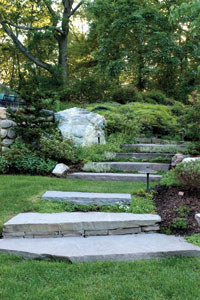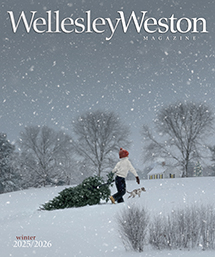Earthly Pleasures
Cheryl B. Scaparrotta writer

Luxurious ponds, serene waterfalls, cozy fireplaces, snazzy barbeque terraces, and well-appointed pool houses. If you think this is a description of a deluxe resort in Aspen or Amalfi, you’ll be surprised to learn these are features found in the backyards of Wellesley and Weston.
It’s true—local residents are spending more downtime on their own grounds, delighting in their very own gardens of Eden. While lush greenery has always promoted backyard bliss, a whole new phenomenon is emerging where infinity pools and outdoor kitchens are becoming the norm.
“I’m finding that with the advent of more people moving into the area from warmer climates, clients are asking for features that previously were only found in California and Florida,” confirms Tony Bernstein, principal of SLDA Landscape Design Associates in Sudbury. “People are going beyond the outdoor swimming pool or spa, planning broader entertaining areas, adding kitchens and other facets to maximize use of their space.”
It’s a trend noticed by many landscape planners in the area. “Our clients want to extend their home into their landscape by creating a nice outdoor space,” agrees Dan Gordon, president of Dan K. Gordon Landscape Associates in Wellesley. “It could be a water feature like a fountain to enhance a courtyard, or a fireplace that creates definition for an open-air room.”
 For many, a vital part of an outdoor entertaining space is the built-in grill, pizza oven, sink, and storage. “We look at elegant ways to accommodate the grill or other special elements,” Gordon says. “We recently customized a Viking grill to match other furnishings on the deck by devising a woven metal surround to match the metal dining furniture. We have also used the same stone found on the terrace to wrap around the grill or oven, so it feels like it’s part of the furnishings.”
For many, a vital part of an outdoor entertaining space is the built-in grill, pizza oven, sink, and storage. “We look at elegant ways to accommodate the grill or other special elements,” Gordon says. “We recently customized a Viking grill to match other furnishings on the deck by devising a woven metal surround to match the metal dining furniture. We have also used the same stone found on the terrace to wrap around the grill or oven, so it feels like it’s part of the furnishings.”
Wellesley resident Mike Skillman hired Dan Gordon to create an attractive and comfortable outdoor living space for family dinners and entertaining guests. His backyard now includes a gas fireplace with a seating area, a built-in gas grill, an eating area, and a Jacuzzi. Outdoor speakers and low-voltage lighting were installed to create ambience. Skillman advises homeowners to visualize how the space will be used over the long-term and says, “Even if you don’t think that you will use something like an outdoor television, a gas grill, or speakers [now], install the utility lines and wiring as it is much easier to add items if you have made these provisions ahead of time.”
A big reason why homeowners are putting such detail into their yards is a desire to use the space longer. “Many people want their yard to last beyond a May-September schedule,” says Eric Joseph, landscape planner at The MacDowell Company in Weston. “Functional aspects that help that happen involve grills surrounded by granite countertops and stone cabinets, warming drawers, and sinks.”
Staying outdoors longer also means remaining there during twilight and evening hours, so adding lights to the exterior landscape is key.
“One way to approach lighting is to do a little “wash” on the architecture, by softly illuminating the house and landscape for a subtle presence,” Gordon says. “And if you go indoors, the outdoor lights visually extends your interior into the nighttime landscape, instead of being separated from it.”
WARMING TREND
Speaking of illumination, there’s a harsh perspective on sunlight. “Unlike years ago, when people baked in the sun, people don’t want to sit unprotected like they used to,” Bernstein observes. “So we take that into consideration when we design outdoor entertainment areas, incorporating gazebos, arbors or pergolas.”
Even old-fashioned shady awnings come with a new twist. “Motorized awnings are a good choice, because they take up very little space when they’re not in use,” he points out.
Mother Nature must be addressed if families realistically want to use outdoor spaces in fall and winter. Heated terraces, walks, and driveways are an option when temperatures go south. “To work properly, heated surfaces require a lot of gas, so specialized boilers must be installed,” explains Joseph. “We prepare a setting bed, and bring in a heating and cooling specialist to install underground radiant tubes that contain antifreeze.”
This system is hooked up to a boiler, and paver stones are placed on top. “There are two sensors that detect moisture and temperature, and at a certain setting, they trigger the heat to come on, essentially melting the snow,” Joseph says. He adds that it’s important to incorporate heated surfaces into the master plan, because drainage must be considered.
However, some take a simpler approach to outdoor living when frosty temps arrive. Stylish heating lamps in stainless steel can warm a radius of 15 feet, while fire pits can range from portable models weighing 30 pounds to built-in versions with elaborate rock ledges and surrounding seating.
 LIQUID ASSETS
LIQUID ASSETS
Water features, including the most traditional one of all—an in-ground pool—are making a big splash in local backyards. But cookie-cutter features like diving boards and kidney-shaped profiles are being swept away by new voices opting for new choices.
“One of the more specialized projects we’re completing for our clients are negative-edge pools,” observes Joseph. Negative-edge pools are distinctive by one or several sides where the water quietly spills over the pool lip into a lower elevation. “Basically, this kind of pool provides an illusion that the pool simply continues on and there’s no edge to it,” Joseph notes. “It offers our customers peace and tranquility on their property.”
Experts say the key to negative-edge pools is to install them in a landscape that truly warrants it. “If we’re dealing with a flat site that has many neighboring houses in view from the yard, then it’s a challenge to make these kinds of pools work,” Joseph emphasizes. “However, if your backyard is surrounded by woods, and there are some higher elevations, then it works very well.” Often, these pools silently flow into a lower waterfall.
Another long-established pool feature that’s being tossed out with the bathwater is the concrete surround. “We like to work with natural stone, which is a nice material for a pool area,” says Gordon. “There’s a range of natural stone to work with, but it has to be durable for this climate.”
He explains that what works in tropical locations simply can’t be used in the more extreme weather of New England. “Limestone, for example, can’t be exposed to the cycle of freezing and thawing, because it will basically turn to powder,” he notes. “Bluestone is a durable natural stone that we use quite a bit. Some people are concerned that a bluestone pool deck will be hot underfoot, but it isn’t any hotter than wood.”
While granite is also user-friendly, it can be costly, especially since it requires special finishes. “There are some durable sandstones that give a nice buff color,” Gordon remarks. “We’re often trying to find different types of materials that work in our area,” he says.
Pool houses to accompany the swimming area are becoming increasingly de rigeur, viewed as a logical key to enjoying aquatic pleasures. “It didn’t seem right to have to track through the house all wet,” explains a Weston resident, who installed a pool, pool house, and Jacuzzi in his yard last year, overseen by Dan K. Gordon Associates. His pool house, which features cedar flooring, offers a place to deposit wet towels, grab a cold drink, and relax.
“We installed a washer and dryer and refrigerator in there, and there’s a central sitting room,” he explains. “There’s also an indoor/outdoor shower.”
Another updated feature he asked for is a hydraulic cover for his 16 foot by 35 foot pool. “I simply press a button to cover it for the season,” says the homeowner. “It’s a very convenient way to live.”
When he was meeting with his family to decide what features to include in their backyard project, his three teenagers took him by surprise. “Our kids felt an outdoor Jacuzzi was just as important to enjoying the yard,” he recalls. “Honestly, I didn’t expect that.” Other aspects to the Weston family’s yard are a barbeque area adjacent to the pool, with gas lines keeping the grill fired up.
SOWING THE RIGHT SEEDS
All the snazzy outdoor features in the world are wonderful, but your yard will seem sparse without proper plantings as a backdrop. But who really wants to care for demanding greenery with that infinity pool beckoning, or tantalizing barbeque aromas wafting by?
“It’s true, people are looking for lower maintenance plantings,” confirms Bernstein. “So, from our design perspective, we try to focus on specimen plantings that are striking and create a focal point, and accent them with perennial plantings that come back yearly.”
For example, decks and patios might feature beautiful pots and planters filled with annuals, to create harmony between the hardscape and the softscape.
“Specimen plantings and ornamental trees like magnolias and Japanese maples, especially the dwarf varieties, have cascading features much like a waterfall, which creates a beautiful effect, especially over a rock bed,” Bernstein remarks. “The landscaping is really driven by the overall objective of the client’s design. A modern, minimalist-type design could be the aforementioned Japanese maple, perhaps accented by grasses. But if your yard contains a tropical, meandering, natural-form pool, it demands a different type of planting.”
To cultivate your own backyard oasis, experts offer sage advice. “It’s advantageous to work with a landscape designer or architect early on, so you can get an overall integrated picture before we have to come in and attempt to remediate a situation that in the end, might not be to your complete liking,” Bernstein cautions.
The Weston resident confirms this reasoning. “Get an expert in the field to oversee your project—don’t assume you can wing it yourself,” he says. “Dan [Gordon] did a fantastic job on our project, and he was definitely one of the high notes in the whole deal. He made it much less stressful than I expected.”
So don’t be put off by the challenges of planning your very own paradise. It seems that elegant and functional can co-exist, even in our fickle New England climate.


recent comments